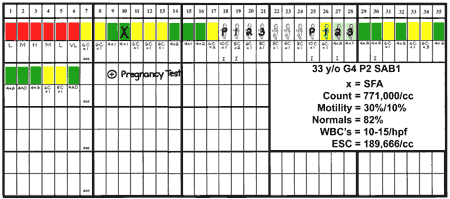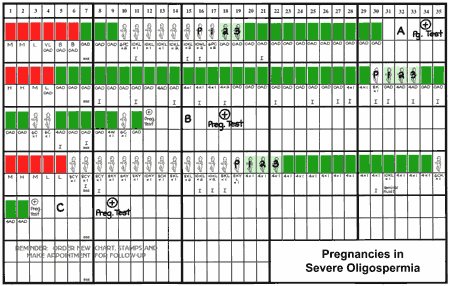
Fertility is a biological function of both the husband and wife, who, through sexual intercourse, unite their gametes. When a woman has difficulty achieving pregnancy, an evaluation for that problem must involve, not only her, but also her husband. This evaluation can be helpful at giving important information to the couple so they may better understand the future capability of their procreative potential. At the same time, it can be a complex and difficult area to work with.
Seminal Fluid Analysis
To assess male fertility, short of a pregnancy, an analysis of seminal fluid is helpful. This can be accomplished in a variety of different ways, some of which are helpful and others which are not. At the same time, some are acceptable to patients while others are not.
The American Society for Reproductive Medicine has made the following recommendation: “At least two semen samples collected on separate days by masturbation are recommended.” Thus, encouraging men to masturbate becomes a part of the standard medical evaluation for infertility; however, this approach to semen collection is dehumanizing and humiliating. Men are usually placed in a washroom with pornographic literature and asked to masturbate. Having spoken to many men about this over the years, it is not well received by most, though they often do not object because it is sort of the “macho” thing to do. It is not something that settles well with most of the male patients that we have seen. In fact, there are many men who refuse a seminal fluid analysis thinking that this is the only way that seminal fluid can be collected. There is, however, an excellent alternative way to collect seminal fluid which does not violate one’s religious, moral or aesthetic beliefs, while at the same time obtaining reliable results. This technique is to use a perforated seminal collection device (SCD). In this fashion, the seminal fluid can be collected with an act of intercourse, at home, in a way which is not contraceptive. When the seminal fluid is collected in this fashion, it needs to be brought to the hospital or to the laboratory with 30 to 45 minutes after collection and it should be kept warm during this period of time. It is preferable for the seminal fluid to be emptied from the collection device into a clean, plastic container prior to being brought into the laboratory.
A number of studies have been conducted over the years which show this type of an approach to the collection of seminal fluid to be very reliable. In fact, this technique has been found to be superior to masturbation or coitus interruptus for the collection of seminal fluid.
NaProTECHNOLOGY in Male Infertility
The Creighton Model System plays a specific role for patients who have difficulty achieving pregnancy when the seminal fluid parameters are abnormal. In such circumstances, identifying the time of fertility with accuracy will assist couples with severe oligospermia to achieve pregnancy. In Figures 47-1 and 47-2, four examples of successful pregnancies in these circumstances are shown. In Figure 47-1, the patient’s husband had a sperm count done on Day 10 of the pregnancy cycle. His effective sperm count (ESC) was 189,666/cc. This was not this patient’s first pregnancy, it was her fourth; however, they had more difficulty achieving this pregnancy than the others. Nonetheless, the only treatment eventually implemented after she had been evaluated and found to be within normal limits was fertility-focused intercourse through the CrMS.

In Figure 47-2, several similar examples are presented. In Patient A, the effective sperm count was 30,000/cc. In Patient B, the ESC was 116,850/cc and in Patient C, the ESC was 50,000/cc. These examples are presented to show the CrMS and NaProTECHNOLOGY can be used to assist couples achieve pregnancy, even when the sperm count is severely decreased.

The normal sperm count should indicate that the number of sperm is 20 million/cc or greater and that the motility (the percentage of sperm that are moving) should be greater than 70 percent. In addition, the morphology (the shape of the sperm) should exceed 60 percent. With regard to the morphology, over the last 15 years, many laboratories have unwittingly changed their classification for the morphology of the sperm. These laboratories have adopted what are referred to as the “strict Kruger criteria.” Based upon a publication in 1988 by Kruger, a very strict classification system has been introduced for the shape of the sperm. With this classification, the morphology is extremely low and still considered to be normal. For example, in many cases, if the morphology is greater than 14 percent, it is considered to be normal. In other words, using this system, 80 to 85 percent of the sperm could be considered to be morphologically abnormal and the sperm count could still be considered normal. This, of course, does not make common sense.
What most people do not realize is that the Kruger system was specifically designed for people who are undertaking treatment by in vitro fertilization or one of the other artificial reproductive technologies. In actual fact, the laboratories have adopted such an approach simply because it has been the general trend to do so. And yet, many couples have no interest in pursuing the in vitro fertilization techniques. Thus, they are obtaining information which is of very limited value to them.
